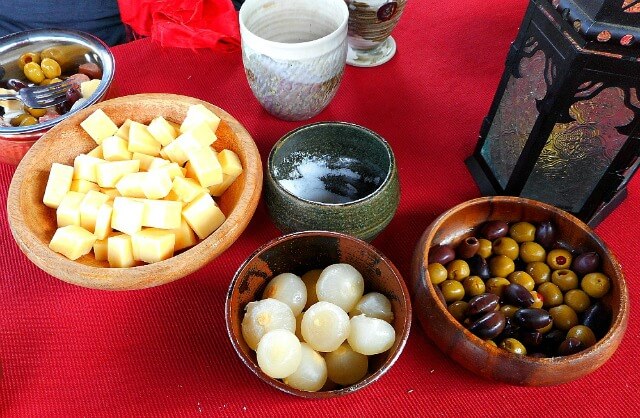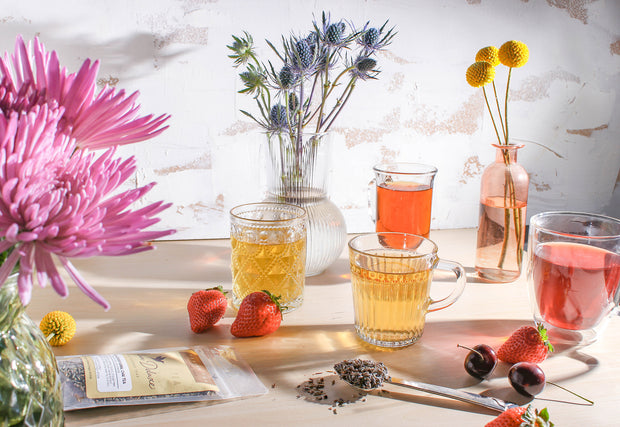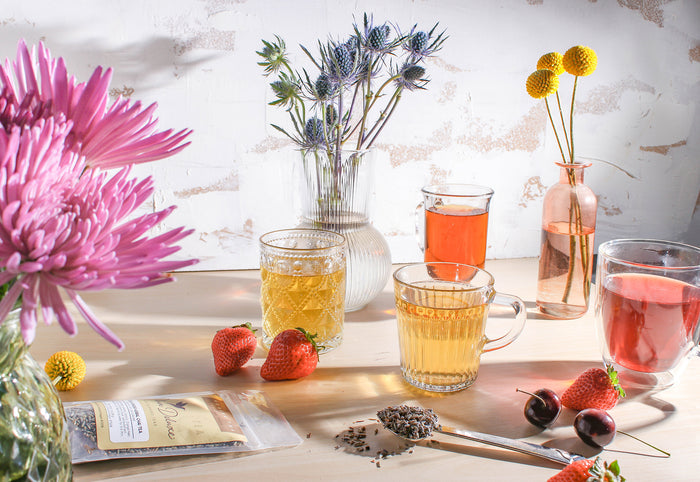Medieval food is a big part of the feasting at our house, especially the slow-roasted meats, homemade cheeses, sausages, and breads. My husband has done medieval enacting for decades and I joined in the fun when we got together four years ago. We're big believers in making medieval food with authentic ingredients in a simple way that tastes delicious.

Preparing the Feast
Putting on a medieval dinner can be as simple or as lavish as you like.
To replicate a peasant meal in medieval times, simply serve your guests a large bowl of gruel, a watery mixture of grains and flour that was drunk rather than eaten.
Or… maybe not. If you prefer something a bit more substantial and celebratory, consider roasting a whole pig, goat, or deer on a spit. There are few things more delicious than slow-cooked meat roasted over an open fire. Basted regularly with its own juices or a flavorful marinade, within 3-4 hours you'll have fork tender, smoky meat as the star of your medieval feast.

Accompanying your roast beast could be an array of period vegetables. Although potatoes, tomatoes, and bell peppers were not available in medieval Europe, you can choose from a host of other vegetables such as artichokes, carrots, tubers, asparagus, parsnips, beets, cabbages, peas, broccoli, various greens, broad beans, mushrooms, and more, all seasoned with garlic, onion, and innumerable herbs and spices that would have been carried along medieval trade routes.

For appetizers, choose an array of cheeses, olives, and medieval-style flatbreads.
Don't stint on dessert. Offer your guests bowls of dried fruits such as cherries, apricots, dates, and figs, and others filled with walnuts, almonds, and hazelnuts. Serve trays of medieval cookies from Italy studded with almonds, or fruit-filled tarts.

Throughout your meal, keep your guests well supplied with medieval grog. Sweet honey mead, ale, beer, and wine are all great options to keep your medieval partiers well lubricated.

Decorate the Feasting Hall
Decorating for a medieval dinner doesn't have to be fancy. Simply set up a long table draped with linen or other period fabric. Provide wooden bowls or bread trenchers for guests to fill with food, and pottery, horn, or wooden cups for them to drink from. Choose candles and lanterns for authentic lighting, and set the mood with ancient tunes from the Middle East, Asia, or even folk tales from England and Scandinavia.

If you want to go all out, invite your guests to dress the part. Women mostly wore long linen or wool dresses with an overdress (similar to a jumper) and an apron with a belt. Men wore loose fitting linen or wool trousers and tunics cinched up with a belt of some sort. If you really want to dress authentically, research medieval garb in your country of choice; show up to the party dressed in the silk robes of a medieval Berber woman or the thickly padded tunic of a Mongolian warrior.

To give the evening a special medieval flair, invite guests to recite poems, tell a gripping story, read an epic Viking saga, or teach everyone a rousing song.
Above all, have fun, relax, and enjoy your crazily dressed friends.

Suggested Medieval Dinner Menu:
Drinks: mead, ale, beer, wine
Appetizers: cheeses, sausages, cured meats, olives, flat breads
Main course: roast beast, period vegetables
Dessert: traditional cookies, cakes, dried and fresh fruits, nuts

Medieval Flat Bread
Ingredients:
- 1 cup plain flour
- 1 cup self-raising flour
- 1/2 teaspoon sea salt
- 3/4 cup plain yogurt
- oil for frying
Preparation:
Mix all ingredients together, kneading to form dough.
Tear off golf ball size pieces, flatten, and roll out thinly.
Heat oil in pan over campfire. Add fry bread and cook 2-3 minutes until top puffs up. Turn and cook another 3-5 minutes until cooked through.
Serve warm.

Simple Cottage Cheese
Ingredients:
- 4 quarts whole milk
- 1/2 teaspoon sea salt
- lemon juice
Preparation:
Over medium-high heat, bring milk and salt almost to a boil, stirring regularly to prevent burning.
Remove from heat and stir in fresh lemon juice. Start with 1 teaspoon and add a bit more until cheese curds begin to form.
When curds are fully separated, strain milk through cheesecloth and let drain. For a soft cheese, only drain for 1 hour; for a firmer cheese, drain overnight.
Serve with flat bread and olives.
Borscht with Apples
Ingredients:
- 1 onion, chopped
- 1 pound raw beetroot, peeled and chopped
- 2 celery sticks, chopped
- 1/2 red bell pepper, chopped
- 1 large cooking apple, chopped
- 2 tablespoon butter
- 2 tablespoon sunflower oil
- 9 cups stock or water
- 1 teaspoon cumin seeds
- a pinch dried thyme
- 1 large bay leaf
- fresh lemon juice
- salt and ground black pepper
- Garnish: sour cream, fresh dill
Preparation:
Place chopped vegetables and apple in large saucepan with butter, oil, and 3 tablespoons stock. Cover and cook gently for about 15 minutes, shaking pan occasionally.
Stir in cumin seeds and cook for 1 minute, then add remaining stock, thyme, bay leaf, lemon juice, and seasoning to taste.
Bring mixture to boil, then cover pan and reduce heat to gentle simmer. Cook about 30 minutes.
Strain vegetables and reserve liquid. Process the vegetables in a food processor or blender until they are smooth and creamy.
Return vegetables to pan, add reserved stock and reheat. Check seasoning.
Divide into individual serving bowls. Garnish with swirls of soured cream and a few sprigs of fresh dill.

![Spring Break Tea Variety Pack [6-Pack Variety of Flavors]](http://www.plumdeluxe.com/cdn/shop/files/spring-break-pack.jpg?v=1740682266&width=165)















